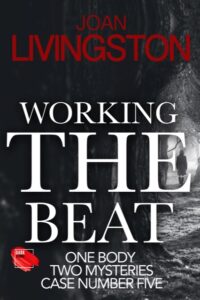A new mystery for Isabel Long often means meeting a person who wants her to solve one. And for me, that means creating a new character. That happened in the second and fourth books, and now on Working the Beat, no. 5 in my Isabel Long Mystery Series.
(In the first book, Chasing the Case, Isabel decided to pursue a cold case that was her first big story  as a rookie reporter 28 years earlier. In the third, Checking the Traps, she gets to know one character from the second better.)
as a rookie reporter 28 years earlier. In the third, Checking the Traps, she gets to know one character from the second better.)
Let me tell you about Shirley Dawson, who hires Isabel for her for her fifth case. As I’ve explained before, writing for me is telepathic. Yes, that sounds nuts. But I sit at my laptop and the story just comes as I type. That includes my characters, such as Shirley, who just pop inside of my brain and became very real for me, and I hope for my readers.
Before I proceed with this topic, I will say Shirley is not based on anybody. Sometimes people who know me like to guess who a character really is. Nice try, but none of what I write is true.
The first thing is to show my readers what Shirley looks like. I do that right off the bat when she approaches Isabel and her mother, Maria, who are taking in the local action at the Titus Country Fair. Shirley taps Isabel on the shoulder.
I turn around to face a woman, actually I’m looking down because she only comes up to my shoulders. I don’t believe she’s as old as my mother, but she’s up there, with white hair cut short and lines on her tanned skin that make me believe she works outside a lot and is a heavy smoker, which I verify when I get closer. Her clothes are a standard-issue baggy flannel shirt hanging over jeans that are faded at the knees from work.
What else can I tell you about Shirley? She hasn’t had an easy life. She had a no-good husband who beat her and their two kids. He died thankfully but not before making their lives miserable. One kid took off and the other sought a better life. So raising Lucas, who was abandoned by his drug-addicted mother, brought joy in her life.
I wanted to create a character who’s a bit on the scratchy side. She drives school bus. Inherited a lot of land. She’s hard of hearing likely from getting knocked around, which Isabel figures out right away. She’s also a hoarder which Isabel and her mother learn when they visit her.
Shirley says she’s heard how Isabel helped other people. Now she wants her to do the same.
And Isabel finds out later that she met Shirley at her former newspaper office when she came seeking answers about her grandson’s death. Isabel couldn’t help her as a journalist but maybe she can as a private investigator.
Once again, Isabel — and I — are suckers for a hard-luck story. Here, I will let Shirley tell you herself.
Shirley stays sitting when she sees us approach. I make our introductions, and then we take the seats opposite her at the picnic table. I make sure I’m in Shirley’s direct line of vision in case she reads lips.
“So, what did you want to talk about?” I ask.
Shirley works her mouth a bit.
“It’s about my grandson, Lucas. Lucas Page is his full name. He was killed here four years ago and whoever did it didn’t get caught.”
“Here in Titus?”
She gives her head a shake.
“I mean here at the fair. It was after the demolition derby, the first one they had. They found Lucas’s body the next morning behind where everybody watches, in the woods up there. They said he must’ve been drunk and fell down in the rocks. His head was hit real bad I was told.”
“What was he doing on the hill afterward? Was he alone?”
“That’s what I want you to find out.”
This story’s coming back to me now. I was the editor of the Daily Star then. We reported on an unattended death at the fair in a story that made the front page, and then like Shirley said, it was ruled an accident because of a brain injury, although she protested that in a story we ran, too.
“Now, I remember you, Shirley. You came to see me in the newsroom. You said you were frustrated the police didn’t seem to be looking that hard into your grandson’s case and you wanted us to do that.”
I think back and hope I treated this woman nicely.
“Yeah, I did. You said newspapers don’t do that kind of work.”
“No, not the one I worked for.”
“But I heard about what you’ve been doin’ now as a private investigator. Your last case was a doozy. Read about it in the paper.” She crooks a thumb toward Annette and her son, still talking with his admirers. “Course, there was Chet Waters. Maybe you can do what the cops couldn’t or wouldn’t do.”
“You mean find out what happened that night with your grandson.”
“Yeah. I heard you get paid for doin’ this. I wanna hear how much. I ain’t got a lot. But this is important to me. I loved my grandson. I’m the one who brought him up after his mother gave him to me. He was hangin’ around with a rough crowd in those days. Tryin’ to fit in. Here. Let me show you his picture.”
Shirley reaches for the purse on the seat beside her. The purse is vintage style, off white with a smart clasp on the top, no zippers, something my mother would use. I am guessing Shirley holds onto things. She removes a photo from her wallet and hands it to me.
“I took it at Christmas, the last one we had,” she says.
Lucas Page’s face smiles at me. He’s young, blue-eyed, and with the kind of features that would label him a good-looking guy. His most distinctive is the red hair that’s short on the sides and long enough on the top so it has a bit of curl. But back to that smile. He was happy to pose for his grandmother.
“He was a handsome young man,” I tell Shirley.
She swipes away a tear.
“Yeah, he was.”
Want to read more? Working the Beat will officially be out Jan. 27, 2022. Kindle users can pre-order now and it will magically appear in your device on that day. Paperback readers, stay tuned.
Thanks for your support. Heres the link: mybook.to/workingthebeat
ABOUT THE PHOTO ABOVE: Taken at the Cummington Fair, the inspiration for the fair in Working the Beat.

